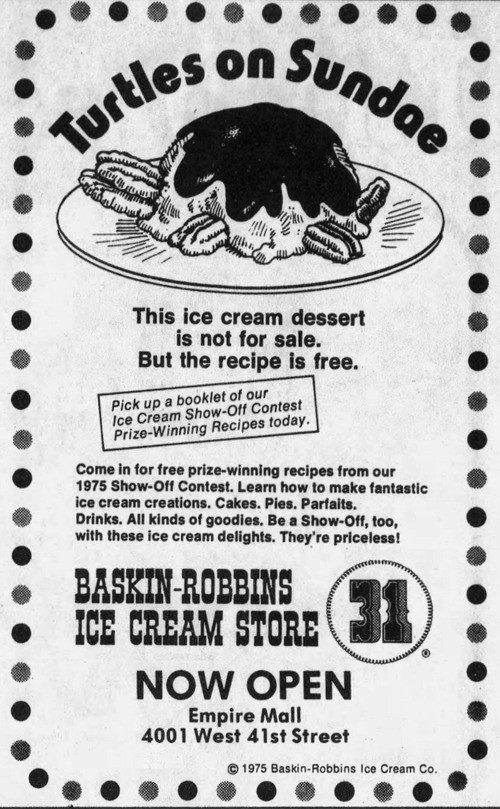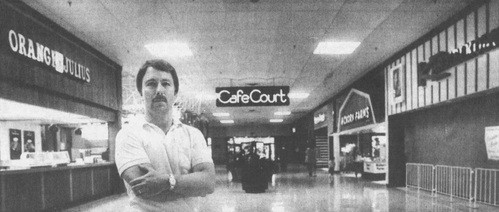Baskin-Robbins
What's better than ice cream? How about 31 flavors of it?
The first Baskin Robbins ice cream shop in Sioux Falls opened in the Empire Plaza on November 26, 1975. Its opening coincided with the opening of the mall itself, Sioux Falls’ second. Baskin Robbins was selling 31 flavors at a growing number of locations worldwide. Innovative flavors and breadth of choice made the company an instant success.
Irv Robbins was born in Winnipeg, Manitoba on December 6, 1917. His father owned The Olympic Store, a dairy store in Tacoma, Washington. Irv was in the ice cream business from a very early age, having worked at the store’s ice cream counter. After serving in the Army during WWII, Irv took the money he’d saved during his service, cashed in an insurance policy he received at his bar mitzvah, and started his own ice cream shop. Snowbird Ice Cream opened in 1945 in Glendale, California. By the time his brother-in-law, Burt Baskin, was discharged from the Navy, Irv was ready to open his fourth store.
Burt “Butch” Baskin was born December 17, 1913, in Streator, Illinois, a short distance southwest of Chicago. Before the war, he worked selling men’s clothing. In the Navy, Burt was stationed in the South Pacific. He managed to secure an ice cream freezer from an aircraft carrier supply officer, and began to make ice cream treats for the other sailors using local tropical fruits. After Burt’s discharge in 1946, Irv was ready to grow his business, so he offered Burt his fourth store. Irv’s father suggested easing into a partnership slowly, so that neither party felt compelled to immediately compromise on his ideas. Burt called his stores Burtons Ice Cream.
All of the stores owned by the pair were successful. The partners spent time coming up with exciting flavor combinations, making their businesses stand out in a world where vanilla, chocolate, and strawberry were the norm. When the two merged in 1951, they saw an opportunity for expansion, but lacked capital. Their solution was to sell some of their stores to their managers. It was a unique way of franchising, but it worked for them. This business model would be used for years to come. The pair settled on each store carrying 31 flavors of ice cream, one for each day of the month — most months anyway. When the pair would come up with new flavors, they’d put them in rotation.
Sioux Falls’ Baskin Robbins location in the new mall assured year-round clientele. Even in the cold months, walking through the mall in one’s coat for hours demanded a cool-down treat. This store was managed by Greg Hauck, who co-owned with business partner Bob Burns.
In 1977, the store in the Empire was put up for sale. Hauck had recently gotten married and was moving to Spokane, Washington. The business was purchased by Pete Larson, who had run Orange Julius in the mall since it opened.
Burt “Butch” Baskin was born December 17, 1913, in Streator, Illinois, a short distance southwest of Chicago. Before the war, he worked selling men’s clothing. In the Navy, Burt was stationed in the South Pacific. He managed to secure an ice cream freezer from an aircraft carrier supply officer, and began to make ice cream treats for the other sailors using local tropical fruits. After Burt’s discharge in 1946, Irv was ready to grow his business, so he offered Burt his fourth store. Irv’s father suggested easing into a partnership slowly, so that neither party felt compelled to immediately compromise on his ideas. Burt called his stores Burtons Ice Cream.
All of the stores owned by the pair were successful. The partners spent time coming up with exciting flavor combinations, making their businesses stand out in a world where vanilla, chocolate, and strawberry were the norm. When the two merged in 1951, they saw an opportunity for expansion, but lacked capital. Their solution was to sell some of their stores to their managers. It was a unique way of franchising, but it worked for them. This business model would be used for years to come. The pair settled on each store carrying 31 flavors of ice cream, one for each day of the month — most months anyway. When the pair would come up with new flavors, they’d put them in rotation.
Sioux Falls’ Baskin Robbins location in the new mall assured year-round clientele. Even in the cold months, walking through the mall in one’s coat for hours demanded a cool-down treat. This store was managed by Greg Hauck, who co-owned with business partner Bob Burns.
In 1977, the store in the Empire was put up for sale. Hauck had recently gotten married and was moving to Spokane, Washington. The business was purchased by Pete Larson, who had run Orange Julius in the mall since it opened.

1975 ad for brand new Baskin-Robbins at the Empire.

Pete Larson, who had reason to look miffed.
A second Baskin Robbins location was built at the northeast corner of 31st and Minnesota in 1979. By 1981, Cindy Kelly Brown had become the owner-manager of the new location. By this time Baskin Robbins had 2,500 locations.
In 1984, Pete Larson sold the Empire Mall location to local broadcasting legend Ken Hirsch. By 1986, rent in the mall was approaching triple what it was at its opening, which drove Hirsch to move the store to the Kelor Plaza at 2701 W. 41st St. Sales of cones dropped drastically at the new location, but specialty items like ice cream cakes and pints improved. With the lower rent, the move improved revenue.
By 1988, the Minnesota Avenue location was for sale and ended up closing. Executive Subs and Salads replaced it in 1989. That same year, Hirsch closed his shop and sold off the freezers and appliances used to run it.
Ice cream can be a terrific business, but in the midwest, finding the right location and rent is a challenge. There’s a reason the Milky Way closes down in the cool months. There are other places to get ice cream these days, and there are more than three basic flavors available, even in supermarkets, but 31 flavor varieties, with a possible 1,400 others in rotation, is not common, and something that would definitely be welcome when the warm months roll around again.
In 1984, Pete Larson sold the Empire Mall location to local broadcasting legend Ken Hirsch. By 1986, rent in the mall was approaching triple what it was at its opening, which drove Hirsch to move the store to the Kelor Plaza at 2701 W. 41st St. Sales of cones dropped drastically at the new location, but specialty items like ice cream cakes and pints improved. With the lower rent, the move improved revenue.
By 1988, the Minnesota Avenue location was for sale and ended up closing. Executive Subs and Salads replaced it in 1989. That same year, Hirsch closed his shop and sold off the freezers and appliances used to run it.
Ice cream can be a terrific business, but in the midwest, finding the right location and rent is a challenge. There’s a reason the Milky Way closes down in the cool months. There are other places to get ice cream these days, and there are more than three basic flavors available, even in supermarkets, but 31 flavor varieties, with a possible 1,400 others in rotation, is not common, and something that would definitely be welcome when the warm months roll around again.
©www.GreetingsFromSiouxFalls.com
